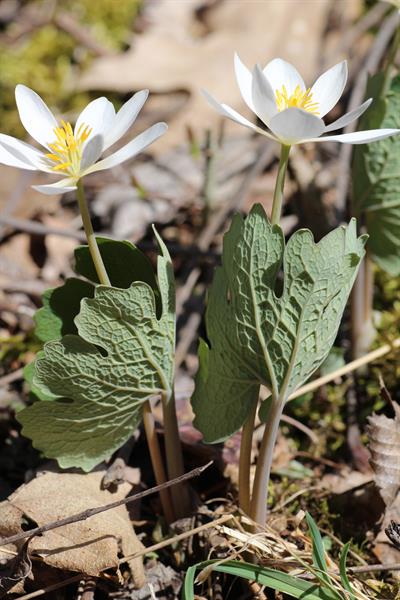
Origin/Endemic status: Native
Taxonomy Comments: Fernald recognized two varieties – var. rotundifolia, more southern and the primary form in our area, considered to have leaves less lobed than the more northern var. canadensis; leaf shape variability within populations makes it impractical to recognize infraspecific taxa.
Synonymy: = Ar, C, Fl2, FNA3, G, GrPl, Il, K1, K3, K4, Mi, NE, NY, Pa, RAB, S, S13, Tat, Tn, Va, W, WH3; > Sanguinaria canadensis L. var. canadensis – F; > Sanguinaria canadensis L. var. rotundifolia (Greene) Fedde – F, Tx
Wetland Indicator Status:
- Atlantic and Gulf Coastal Plain: UPL
- Eastern Mountains and Piedmont: UPL
- Great Plains: UPL
- Midwest: FACU
- Northcentral & Northeast: FACU
Heliophily: 2
Hover over a shape, letter, icon, or arrow on the map for definition or see the legend.
 © Scott Ward | Original Image ⭷
© Scott Ward | Original Image ⭷ © Bruce A. Sorrie | Original Image ⭷
© Bruce A. Sorrie | Original Image ⭷ © Erik Danielson source | Original Image ⭷
© Erik Danielson source | Original Image ⭷ © Scott Ward | Original Image ⭷
© Scott Ward | Original Image ⭷ © Gary P. Fleming | Original Image ⭷
© Gary P. Fleming | Original Image ⭷ © Scott Ward | Original Image ⭷
© Scott Ward | Original Image ⭷ © Gary P. Fleming | Original Image ⭷
© Gary P. Fleming | Original Image ⭷ © Alan Cressler: Sanguinaria canadensis, Georgia 1 by Alan Cressler source | Original Image ⭷
© Alan Cressler: Sanguinaria canadensis, Georgia 1 by Alan Cressler source | Original Image ⭷ © Scott Ward | Original Image ⭷
© Scott Ward | Original Image ⭷ © Gary P. Fleming | Original Image ⭷
© Gary P. Fleming | Original Image ⭷ © Richard & Teresa Ware CC-BY-NC, permission granted to NCBG | Original Image ⭷
© Richard & Teresa Ware CC-BY-NC, permission granted to NCBG | Original Image ⭷Feedback
See something wrong or missing on about Sanguinaria canadensis? Let us know here: (Please include your name and email if at all complicated so we can clarify if needed.)
Cite as...